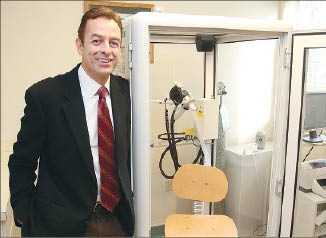
Home » Through its network, occupational medicine clinic grows
Through its network, occupational medicine clinic grows
Two offices manage injured clients' cases through claims maze

November 17, 2011
Spokane Regional Occupational Medicine, an entity of Valley Hospital, says it uses its integrated medical network here to help injured workers recover and return to work as quickly as possible, while reducing potential costs for patients, employers, and the state of Washington.
The clinic, based in 2,200 square feet of space at 1512 N. Vercler in Spokane Valley, just east of Valley Hospital, sees about 125 patients a week, a fivefold increase from when it opened two years ago with a three-person staff, including one physician, says John Smith, its director of operations.
The clinic in August opened a North Side office, at 605 E. Holland, where it occupies 1,500 square feet of floor space, and now has a combined staff of 14, including two physicians and two physician assistants, Smith says.
Spokane Regional Occupational Medicine also has recruited a third physician, who will join the clinic next June, he says.
The specialty clinic's network of service providers also includes Deaconess Hospital, in Spokane; Spokane-based Rockwood Health System; and seven affiliated Spokane-area urgent-care centers, all of which are part of Franklin, Tenn.-based Community Health Systems Inc., Smith says.
Tom Martin, the clinic's program integration specialist, says Spokane Regional Occupational Medicine provides a specialty within specialties.
"There's not a lot of physicians in general who feel comfortable treating occupational injuries," Martin says. "There's a stigma of a lot of paperwork."
Recovery from a workplace injury often involves treatment by a number of specialists and therapists, all of which must be filtered through the Washington state Department of Labor and Industries' claims process.
Smith adds, "Our specialty is case management for that claim."
Martin says back injuries that occur in industrial situations in which workers lift and move heavy objects are the most common form of injuries treated at the clinic. Other injuries treated there, often related to industrial workplaces, involve damage to shoulder and arm muscles, or bones and joints, as well as lacerations, burns, and crush trauma.
Dr. Christopher Goodwin, medical director at Spokane Regional Occupational Medicine, says the clinic helps create recovery plans for patients as early as their first visit to the clinic.
"We'll often know right from that day when they should be back to work," Goodwin says. "That should be part of the patient's mindset."
Once a patient is referred to Spokane Regional Occupational Medicine—usually through a provider or urgent-care center within the integrated network, the clinic assesses the injury and arranges imaging and diagnostic services, if needed, Martin says. Test results then go directly to Spokane Regional Occupational Medicine, which develops a treatment and recovery plan with the patient. Treatment is referred to providers—most likely within the clinic's network—and can range from surgery to therapy.
"Through our network, we can offer access to services as fast as possible," Martin says.
That can reduce costs to the employer in terms of loss of productivity, Goodwin adds. Also, by minimizing the amount of time the patient is absent from the workplace, it helps ensure the patient remains employed and insured, he says.
"We've shown we can reduce costs across the board," Martin says.
Spokane Regional Occupational Medicine always is an advocate for the patient, but also keeps the interests of the state and the employer in mind, he says.
"The patient wants to get better, the employer wants a plan, and the state wants progression in the claim," Martin says.
Outside of such a network, a primary care provider would have to refer the patient to unaffiliated diagnostic service providers and specialists, which likely would prolong treatment and recovery, increasing costs for the patient and employer, he asserts.
Sometimes the clinic's physicians will recommend restricted work duties for the patient, but they rarely prohibit patients from returning to work at some point during their recovery.
"They may say 'restricted,' but the employee still can be productive," Martin says. "More often than not, the employer understands, although in some cases the employer can't accommodate restricted duties."
Goodwin says office settings aren't immune to workplace injuries.
Despite increased attention given to office ergonomics in recent years, "Repetitive motion injuries are more prevalent than people realize," he says.
One of the more common types of repetitive motion injury is carpal tunnel syndrome, which occurs mostly among people in office, retail, and manufacturing settings who use computer keyboards extensively.
Treatment for carpal tunnel syndrome carries the highest average cost per case among workplace injuries, Goodwin says.
Often, though, patients eventually can return to their previous work tasks following treatment, which can include anti-inflammatory drugs, splints, and surgery, he says.
Under certain scenarios, employers and employees need to confirm whether the patient is ready to perform work duties. In such a case, an occupational and physical therapist will conduct a two-day test in which the patient simulates job-related tasks.
"If the test results are positive, everyone knows it's safe for the employee to go back to work," Martin says.
Spokane Regional Occupational Medicine also is developing protocols to treat patients quickly for contaminated needle sticks and exposure to blood-borne pathogens, such as HIV, and hepatitis B and C.
In addition to people in the medical and health-care industries, law-enforcement and corrections personnel are at risk for such exposures, Smith says. The program includes baseline testing, monitoring, ongoing treatment, and counseling, he says.
Spokane Regional Occupational Medicine also offers flu, tetanus, and whooping cough vaccinations.
Other services the clinic provides include drug screening, hearing tests, and lung-capacity measurements. It also conducts physical examinations required for participation in sports, immigration eligibility, and employment with the Washington state Department of Transportation.
Latest News
Related Articles





![Brad head shot[1] web](https://www.spokanejournal.com/ext/resources/2025/03/10/thumb/Brad-Head-Shot[1]_web.jpg?1741642753)